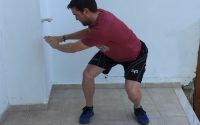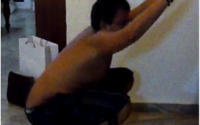The Mid-Tarsal Joint
The Mid-Tarsal Joint (MTJ is one that definitely didn’t get as much attention as the other joints, but as the foot needs to work as a unit it is just as important. In fact the MTJ often holds the key to a few injuries that many of us will have suffered from at some point…like plantarfasciitis (or opathy!) or a posterior tib. tendonopathy etc. So let us explore the MTJ function, assessment and treatment.
Mid Tarsal in Function
The MTJ is described as a functional joint, made up of the talo-navicular joint on the medial side and the calcneo-cuboid joint on the lateral side. It’s an interesting one to study in gait, as in this case the distal bones are relatively fixed, meaning that the motion at the joint is driven from the proximal bone motions even as a front foot. For example, (we’ll use the talo-navicular joint in this example to keep things simple) during the front foot load in gait, the mid tarsal joint will be driven by the motions of the rear foot, the talus in this case. As the foot loads, the talus is driven anteriorly, tilting to the left (everting) and rotating to the left…this results in dorsiflexion, inversion and abduction (also known as external rotation) at the mid-tarsal joint.
The real magic of the mid tarsal joint is in it’s ability to ‘lock’ and ‘unlock’ during different phases of gait in order to make it more efficient. When the rear foot is everted, the MTJ is able to offer a relatively large range in all three planes of motion…however, when the rear foot is inverted the MTJ is relatively stable and has less range in all three planes. This mechanism is brilliant (when it is working) as it allows a flexible foot on impact that is able to adapt to the surface and truly load and then as a rear foot in gait the foot because stiff and is a good platform to drive force through…brilliant
Mid Tarsal Assessment
I will get a feel for the MTJ function from all the assessments of the foot…in gait, in squats and off weight bearing. All of the above are important, but in particular I will pay attention to gait and the off weight bearing assessment in this case.
In gait, it is the relationship of the forefoot and the rear foot that is important…I am particularly looking at where they get the dorsiflexion from in gait, if there is not enough talo-crural dorsiflexion, then the sub-talar joint will pronate late in gait in order to access the dorsiflexion from the sub-talar joint and the mid tarsal joint. This is pretty easy to see once you know what you are looking for. This is a fairly common pattern and means that the ‘locking’ mechanism described above cannot be used, which leads to ‘pushing off’ a relatively flexible foot…increasing the amount of force going through the plantar fascia and the other soft tissue structures…a recipe for injury!
Ironically, one of the pictures I use for foot posts shows a person walking on a beach, they are definitely lacking dorsiflexion, pronating late in the gait cycle and have unlocked their MTJ…see below!!
Off weight bearing I will do a simple test, checking mid-tarsal joint motion in all 3 planes while I hold the rear foot everted and then repeat with the rear foot inverted. Obviously, there should be less motion with the rear foot inverted and so you get a very quick and clear picture of the MTJ function from this. One word of caution is that in gait the rear foot does not invert a huge amount, so during this off weight bearing assessment you need to bear in mind how far you are inverting the rear foot. Even if the MTJ locks with full inversion the mechanism will still ‘fail’ in gait as it can’t get to that end range. So the assessment becomes where in the range does it lock as well as if it does or doesn’t.
In a different type of dysfunction, if the MTJ is very stiff and not offering the motion you feel is necessary, you get this very clearly from the off weight bearing assessment. If the motion is very limited it is easy to feel and is often a much easier dysfunction to treat.
Mid Tarsal Treatment
Lets take that last point of a stiff MTJ first. I tend to treat the foot off weight bearing first and then add the function in straight after…this is just something that I have found works well for me. To mobilise the MTJ I tend to think rear foot and forefoot (I like simple!) I hold the forefoot relatively still and drive motion through the rear foot to create MTJ motion. The body seems to respond well to this as this is similar to what happens in gait. In a right foot for example, while holding the forefoot still I will drive the rear foot through eversion and internal rotation to create the front foot motions at the mid tarsal joint…simple as that! It takes very little force and the body responds really well. Once I am happy with that I will move onto rear foot motions by driving the rear foot through inversion and external rotation. Once I’ve completed that I will get them standing and drive the same motions in function, with either the dorsiflexion matrix or a simple pivot exercise, using hands on to start with and then asking them to continue with that as one of their home exercises.
The example of a MTJ not locking is a lot more tricky to deal with…the real question is why? You need to address the root cause (as ever) so the MTJ may not by directly addressed at first. The usual suspect is a lack of dorsiflexion, so I will go after that (see 5 ways of getting dorsiflexion for my strategies), but not forgetting other suspects like lack of hip range (especially extension and internal rotation) and the function of the other leg. Once I feel I am getting somewhere with the root cause I will start to get the patient some stability around the foot. I get them bear foot and I tend to use transverse plane pivot and balance reaches driving the rear foot into inversion and trying to get that MTJ to lock. If we use a right foot again I will get them reaching their left forwards and to the right to create the inversion in the right foot.
This strategy works really well, but is by no means always successful. Some feet will never lock, I’m sure we’ve all assessed feet that look and feel like a bag of bones and don’t seem to have any structural integrity. I still use the same strategies, but I don’t expect to achieve locking…I just want the best function I can get. In this case an orthotic may be a good option.
Sorry about the mammoth post!!! I didn’t realise I had so much to say about the MTJ…hope you find it useful
Physioblogger

